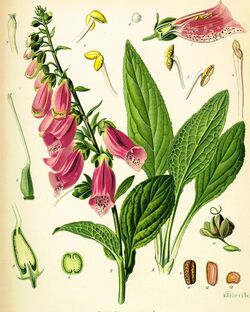Biography:Walther Otto Müller
From HandWiki
Revision as of 17:39, 23 July 2022 by imported>MainAI6 (change)

Digitalis purpurea Illustrated and lithographed by Walter Müller from Gera
Walther Otto Müller, also Otto Müller, (20 June 1833 – 17 July 1887, in Gera) was a German botanist and gardner.[1] He was mainly interested in Cryptogamae, in particular lichen and mosses. Müller was the author of some books and several articles in scientific and botanical journals.[1] He monochrome illustrated at least one. He collected plants, lichen and mosses for herbaria to sell the exsiccates as loose-leaf-collections.[2]
The topography of Gera region provided flora and fauna from lowland and highland at one rich spot.[1] Some of his specimens are housed at the British Museum.
Some confuse him with:
- Walther Müller, German lithographer in Gera, who somewhen changed the spelling to Walter Müller, complete name Wilhelm Walter Müller (1845-1927), working from 1870 to 1919 as an illustrator, lithographer who produced botanical and anatomical drawing, lithography, chromolithography and hand-colouring, marking with italics WM or WMüller (VIAF-ID: 236205928).
- Otto Müller, German botanist in Berlin, complete name Georg Ferdinand Otto Müller (1837-1917), who collected and studied algae (Diatomaceae, Bacillariaceae) from 1870 up to 1912. He has the taxonomic author abbreviation O.Müll. (VIAF ID: 295723048).
- Otto Müller, German botanist in Breslau (nowadays Wrocław), who did research in the field of plant physiology of vine 1887.
Works
- Flora der Reussischen Länder und deren nächster Umgebungen (1863) [1]
- Cryptogamen-Flora enthaltend die Abbildung und Beschreibung der vorzüglichsten Cryptogamen Deutschlands. - Gustav Pabst and Walther Otto Müller - Gera, C.B. Griesbach, 1874-1877. 3 parts in 1 volume. Large 4to (33 x 24.5 cm). With 12 numbered lithographed plates by C. Bollmann (Gera) in part 1 which was written jointly by Pabst and Müller; several wood engravings in text and 25 (numbered 23) chromolithographed plates by J.G. Bach (Leipzig) in part 2; illustrations by Müller and Pabst - 1 lithographed and 8 numbered chromo-lithographed plates by Franz Dietsch (Gera) in part 3. Parts 2 and 3 were written by Pabst.[4][5][6]
References
- ↑ 1.0 1.1 1.2 Frahm & Eggers: Lexikon deutschsprachiger Bryologen.
- ↑ "317290221". http://viaf.org/viaf/317290221.
- ↑ IPNI, W.O.Müll., http://www.ipni.org/ipni/advAuthorSearch.do?find_abbreviation=W.O.Müll.
- ↑ Cryptogamen-Flora : I. Theil : Flechten.
- ↑ Cryptogamen-Flora : II. Theil : Die Pilze.
- ↑ Die Lebernoose. (Cryptogamen-Flora. - III. Theil.)
External links
 |

